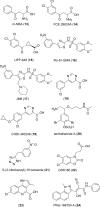Major Developments in the Design of Inhibitors along the Kynurenine Pathway
- PMID: 28464785
- PMCID: PMC5748880
- DOI: 10.2174/0929867324666170502123114
Major Developments in the Design of Inhibitors along the Kynurenine Pathway
Abstract
Disrupted kynurenine pathway (KP) metabolism has been implicated in the progression of neurodegenerative disease, psychiatric disorders and cancer. Modulation of enzyme activity along this pathway may therefore offer potential new therapeutic strategies for these conditions. Considering their prominent positions in the KP, the enzymes indoleamine 2,3-dioxygenase, kynurenine 3-monooxygenase and kynurenine aminotransferase, appear the most attractive targets. Already, increasing interest in this pathway has led to the identification of a number of potent and selective enzyme inhibitors with promising pre-clinical data and the elucidation of several enzyme crystal structures provides scope to rationalize the molecular mechanisms of inhibitor activity. The field seems poised to yield one or more inhibitors that should find clinical utility.
Keywords: 3-dioxygenase; Kynurenine pathway; cancer; enzyme inhibitors; indoleamine 2; kynurenine 3- monooxygenase; neurodegeneration.
Copyright© Bentham Science Publishers; For any queries, please email at epub@benthamscience.org.
Figures






Similar articles
-
Challenges and Opportunities in the Discovery of New Therapeutics Targeting the Kynurenine Pathway.J Med Chem. 2015 Nov 25;58(22):8762-82. doi: 10.1021/acs.jmedchem.5b00461. Epub 2015 Aug 5. J Med Chem. 2015. PMID: 26207924 Review.
-
Abnormal kynurenine pathway of tryptophan catabolism in cardiovascular diseases.Cell Mol Life Sci. 2017 Aug;74(16):2899-2916. doi: 10.1007/s00018-017-2504-2. Epub 2017 Mar 17. Cell Mol Life Sci. 2017. PMID: 28314892 Free PMC article. Review.
-
The kynurenine pathway as a therapeutic target in cognitive and neurodegenerative disorders.Br J Pharmacol. 2013 Jul;169(6):1211-27. doi: 10.1111/bph.12230. Br J Pharmacol. 2013. PMID: 23647169 Free PMC article. Review.
-
Genetic alterations affecting the genes encoding the enzymes of the kynurenine pathway and their association with human diseases.Mutat Res Rev Mutat Res. 2018 Apr-Jun;776:32-45. doi: 10.1016/j.mrrev.2018.03.001. Epub 2018 Mar 14. Mutat Res Rev Mutat Res. 2018. PMID: 29807576 Review.
-
The inhibition of the kynurenine pathway prevents behavioral disturbances and oxidative stress in the brain of adult rats subjected to an animal model of schizophrenia.Prog Neuropsychopharmacol Biol Psychiatry. 2018 Feb 2;81:55-63. doi: 10.1016/j.pnpbp.2017.10.009. Epub 2017 Oct 13. Prog Neuropsychopharmacol Biol Psychiatry. 2018. PMID: 29030243
Cited by
-
Tryptophan Pathway Abnormalities in a Murine Model of Hereditary Glaucoma.Int J Mol Sci. 2021 Jan 21;22(3):1039. doi: 10.3390/ijms22031039. Int J Mol Sci. 2021. PMID: 33494373 Free PMC article.
-
Metabolic Heterogeneity, Plasticity, and Adaptation to "Glutamine Addiction" in Cancer Cells: The Role of Glutaminase and the GTωA [Glutamine Transaminase-ω-Amidase (Glutaminase II)] Pathway.Biology (Basel). 2023 Aug 14;12(8):1131. doi: 10.3390/biology12081131. Biology (Basel). 2023. PMID: 37627015 Free PMC article. Review.
-
The effects of aging on host resistance and disease tolerance to SARS-CoV-2 infection.FEBS J. 2021 Sep;288(17):5055-5070. doi: 10.1111/febs.15613. Epub 2020 Nov 17. FEBS J. 2021. PMID: 33124149 Free PMC article. Review.
-
The Influence of Kynurenine Metabolites on Neurodegenerative Pathologies.Int J Mol Sci. 2024 Jan 10;25(2):853. doi: 10.3390/ijms25020853. Int J Mol Sci. 2024. PMID: 38255925 Free PMC article. Review.
-
Inhibition of human kynurenine aminotransferase isozymes by estrogen and its derivatives.Sci Rep. 2017 Dec 14;7(1):17559. doi: 10.1038/s41598-017-17979-7. Sci Rep. 2017. PMID: 29242525 Free PMC article.
References
-
- Munn D.H., Zhou M., Attwood J.T., Bondarev I., Conway S.J., Marshall B., Brown C., Mellor A.L. Prevention of allogeneic fetal rejection by tryptophan catabolism. Science. 1998;281(5380):1191–1193. - PubMed
-
- Uyttenhove C., Pilotte L., Théate I., Stroobant V., Colau D., Parmentier N., Boon T., Van den Eynde B.J. Evidence for a tumoral immune resistance mechanism based on tryptophan degradation by indoleamine 2,3-dioxygenase. Nat. Med. 2003;9(10):1269–1274. - PubMed
-
- Koblish H.K., Hansbury M.J., Bowman K.J., Yang G., Neilan C.L., Haley P.J., Burn T.C., Waeltz P., Sparks R.B., Yue E.W., Combs A.P., Scherle P.A., Vaddi K., Fridman J.S. Hydroxyamidine inhibitors of indoleamine-2,3-dioxygenase potently suppress systemic tryptophan catabolism and the growth of IDO-expressing tumors. Mol. Cancer Ther. 2010;9(2):489–498. - PubMed
-
- Nayak A., Hao Z., Sadek R., Vahanian N., Ramsey W.J., Kennedy E., Mautino M., Link C., Bourbo P., Dobbins R., Adams K., Diamond A., Marshall L., Munn D.H., Janik J., Khleif S.N. A Phase I study of NLG919 for adult patients with recurrent advanced solid tumors. J. Immunother. Cancer. 2014;2(Suppl. 3):250–P250.
Publication types
MeSH terms
Substances
LinkOut - more resources
Full Text Sources
Other Literature Sources

